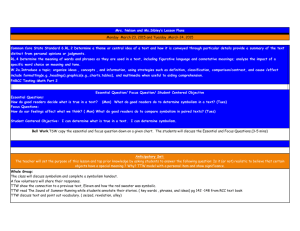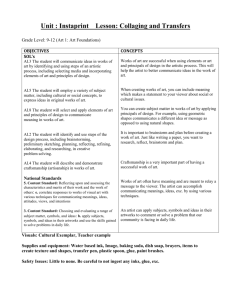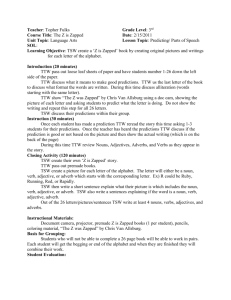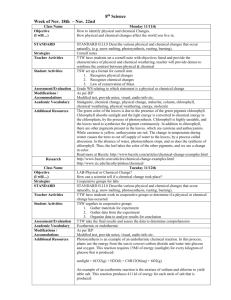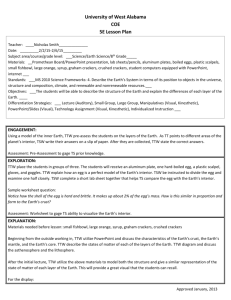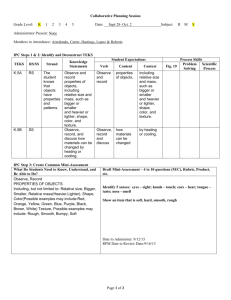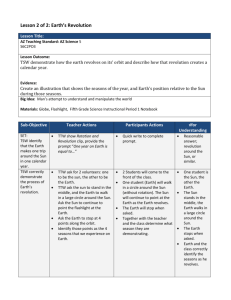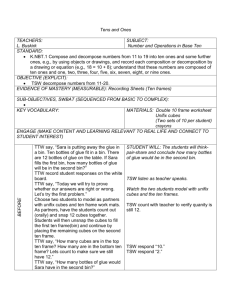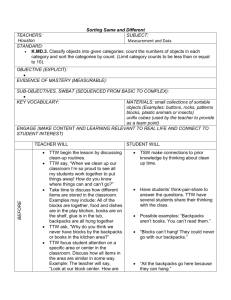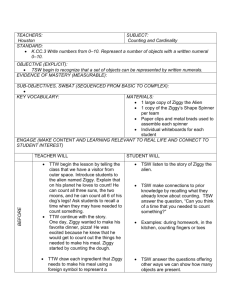Highlighted_Unit_Plans
advertisement
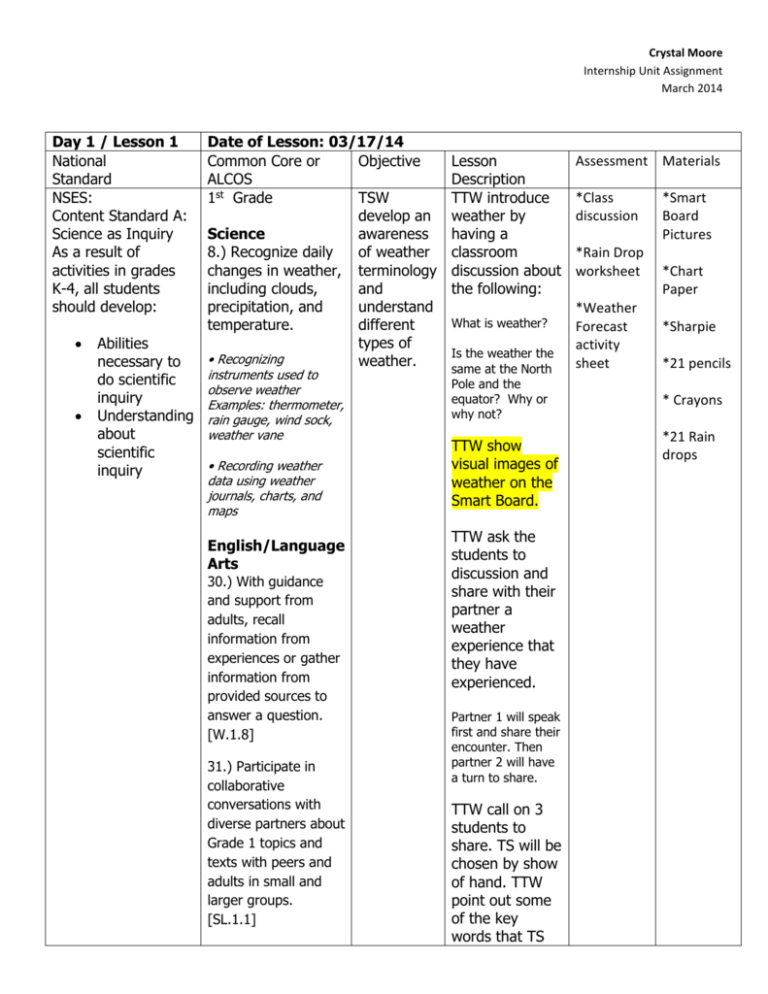
Crystal Moore Internship Unit Assignment March 2014 Day 1 / Lesson 1 National Standard NSES: Content Standard A: Science as Inquiry As a result of activities in grades K-4, all students should develop: Abilities necessary to do scientific inquiry Understanding about scientific inquiry Date of Lesson: 03/17/14 Common Core or Objective ALCOS 1st Grade TSW develop an Science awareness 8.) Recognize daily of weather changes in weather, terminology including clouds, and precipitation, and understand temperature. different types of • Recognizing weather. instruments used to observe weather Examples: thermometer, rain gauge, wind sock, weather vane • Recording weather data using weather journals, charts, and maps English/Language Arts 30.) With guidance and support from adults, recall information from experiences or gather information from provided sources to answer a question. [W.1.8] 31.) Participate in collaborative conversations with diverse partners about Grade 1 topics and texts with peers and adults in small and larger groups. [SL.1.1] Lesson Description TTW introduce weather by having a classroom discussion about the following: What is weather? Is the weather the same at the North Pole and the equator? Why or why not? TTW show visual images of weather on the Smart Board. TTW ask the students to discussion and share with their partner a weather experience that they have experienced. Partner 1 will speak first and share their encounter. Then partner 2 will have a turn to share. TTW call on 3 students to share. TS will be chosen by show of hand. TTW point out some of the key words that TS Assessment Materials *Class discussion *Rain Drop worksheet *Weather Forecast activity sheet *Smart Board Pictures *Chart Paper *Sharpie *21 pencils * Crayons *21 Rain drops Crystal Moore Internship Unit Assignment March 2014 a. Follow agreed-upon rules for discussions (e.g., listening to others with care, speaking one at a time about the topics and texts under discussion). [SL.1.1a] use, such as, windy, snowing, etc. TTW introduce weather terminology such as: Rain, chilly, snow, freezing, hot, storm, rainbow, icicles, Spring, Fall, Winter, Summer, tornado, blizzard. TTW and TSW create an anchor chart with Weather Words. TS will pick their favorite weather word and use the Rain Drops to write and illustrate their word. TS will share their words with the class. TTW recap today’s lesson and give TS a chance to ask questions to clear up misconceptions. Crystal Moore Internship Unit Assignment March 2014 Crystal Moore Internship Unit Assignment March 2014 Day 2 / Lesson 2 National Standard Content Standard A: Science as Inquiry As a result of activities in grades K-4, all students should develop: *Abilities necessary to do scientific inquiry *Understanding about scientific inquiry Date of Lesson: 03/18/14 Common Core or ALCOS 1st Grade Science 8.) Recognize daily changes in weather, including clouds, precipitation, and temperature. • Recognizing instruments used to observe weather Examples: thermometer, rain gauge, wind sock, weather vane • Recording weather data using weather journals, charts, and maps Mathematics 18.) Organize, represent, and interpret data with up to three categories; ask and answer questions about the total number of data points, how many in each category, and how many more or less are in one category Objective Lesson Description TSW develop TTW introduce awareness of cloud types by cloud types, asking TS as well as, “Raise your graph and hand if you assist with have ever interpreting looked up in the data the sky at the obtained clouds?” from the graph. TTW ask “What did you see? Did all the clouds look the same?” TTW use equity sticks to call on TS to respond. TTW say “Today, we are going to learn about different types of clouds!” TTW use the Smart Board to explain and show visual images of stratus, cirrus, cumulonimbus, and cumulus clouds. TT and TS will briefly discuss how clouds are formed. Assessment Materials *Classroom discussion and participation *Smart Board cloud pictures, graph, observation and interpretation of data * Teacher observation *Chart Paper *Sharpie *Little Cloud by Eric Carle (Optional) Crystal Moore Internship Unit Assignment March 2014 than in another. [1-MD4] TT and TS will graph (on the smart board) each students’ favorite type of cloud. TT and TS will make observations and interpret the cloud data. TTW recap today’s lesson and give TS a chance to ask questions to clear up misconceptions TTW end the discussion with asking TS to look up in the sky when they are on their way home to try to identify some of the clouds types that we have discussed today. Crystal Moore Internship Unit Assignment March 2014 Day 3 / Lesson 3 National Standard Date of Lesson: 03/19/14 Common Objective Core or ALCOS NSES: 1st Grade TSW learn Content Standard A: about the Science as Inquiry Science water cycle, As a result of 8.) condensation, activities in grades Recognize evaporation, K-4, all students daily and should develop: changes in precipitation. weather, including Abilities clouds, necessary to do scientific precipitation, and inquiry Understanding temperature. about • Recognizing scientific instruments inquiry used to observe weather Examples: thermometer, rain gauge, wind sock, weather vane • Recording weather data using weather journals, charts, and maps Lesson Description Assessment Materials TTW say “Yesterday we learned about clouds and today we are going to learn about the water cycle.” *Teacher *Smart Board observation (Poster) TTW ask “How do you think the clouds and the water cycle are related?” *Water cycle labeling activity *21 copies of water cycle labels *21 pieces of construction paper *21 Glue sticks *21 pencils TSW raise their hand to respond. TTW explain that the clouds and the water cycle are related because the water cycle helps form the clouds. TTW use the Smart board to show and discuss the following: Condensation, precipitation, and evaporation. What is condensation? How is it formed? What is precipitation and how is it formed? What is evaporation? *Class set of crayons Crystal Moore Internship Unit Assignment March 2014 After discussion, TT will give directions and TSW cut out, label, and illustrate the water cycle on construction paper. TTW recap today’s lesson and give TS a chance to ask questions to clear up misconceptions. Crystal Moore Internship Unit Assignment March 2014 Day 4/ Lesson 4 National Standard Content Standard A: Science as Inquiry As a result of activities in grades K-4, all students should develop: *Abilities necessary to do scientific inquiry *Understanding about scientific inquiry Date of Lesson: 03/20/14 Common Core or ALCOS 1st Grade Science 8.) Recognize daily changes in weather, including clouds, precipitation, and temperature. • Recognizing instruments used to observe weather Examples: thermometer, rain gauge, wind sock, weather vane • Recording weather data using weather journals, charts, and maps English/ Language arts: 31.) Participate in collaborative conversations with diverse partners about Grade 1 topics and texts with peers and adults in small and larger Objective Lesson Description TSW develop TTW show TS awareness of a thermometer weather and ask, “By tools show of hand, who knows what this is and what its purpose is?” TS will respond by show of hand. TTW introduce the thermometer and clear up any misconceptions about the thermometer. TTW say “Today we are going to learn about weather tools also known as instruments. What are some other tools we use for weather?” TS will raise their hand to respond. TTW introduce and explain the following tools: Assessment Materials * Teacher observation * Outdoor thermometer *Weather tools sorting sheets *21 Red crayons *21 Pencils *21 Record sheets *21 weather tools sorting sheets Crystal Moore Internship Unit Assignment March 2014 groups. [SL.1.1] c. Ask questions to clear up any confusion about the topics and texts under discussion. [SL.1.1c] Thermometer: Temperature Hygrometer: Humidity Wind Vane: Direction of wind Rain Gauge: Amount of rain TTW use the Smart Board to offer a visual for visual learners. TTW use the Hoover Cam to show an actual thermometer and TS will color in the correct temperature on the Temp. sheet. TTW say “Now, we are going to talk about scenarios and the tools that we might use during these situations.” TSW complete the Weather Tools scenario activity sheet to obtain a further understanding of the use of weather tools. Crystal Moore Internship Unit Assignment March 2014 TTW recap weather tools and give TS a chance to ask questions throughout the lesson to clear any misconceptions See below… Crystal Moore Internship Unit Assignment March 2014 Name:___________________________________ Date:______________________________ Weather Tools Thermometer Hygrometer Wind Vane Rain Gauge Crystal Moore Internship Unit Assignment March 2014 You’re outdoors and you notice that your skin feels a little “moist and sticky.” Which instrument would give you information based on your experience? You’re outdoors and you notice that the trees are blowing in the same direction. Which instrument would give you information based on your experience? You’re outdoors and you notice that you have to take off your jacket. Which instrument would give you information based on your experience? You’re outdoors and you see liquid precipitation falling from the sky. In order to measure, you try capturing it in your hands, but it’s too difficult. Which instrument would give you information based on your experience? Crystal Moore Internship Unit Assignment March 2014 Crystal Moore Internship Unit Assignment March 2014 Day 5/ Lesson 5 National Standard Content Standard A: Science as Inquiry As a result of activities in grades K-4, all students should develop: *Abilities necessary to do scientific inquiry *Understanding about scientific inquiry Date of Lesson: 03/21/14 Common Core or ALCOS 1st Grade Science 8.) Recognize daily changes in weather, including clouds, precipitation, and temperature. • Recognizing instruments used to observe weather Examples: thermometer, rain gauge, wind sock, weather vane • Recording weather data using weather journals, charts, and maps Objective Lesson Description TSW develop Prior to the awareness of lesson TS will wind pack up to dismiss. The end of this lesson will be held outside. (This lesson is at the end of the day) TTW say “Yesterday we discussed weather tools. Raise your hand if you remember which tool helps determine wind.” TS will respond with wind vane. TTW say “Well, today we are going to learn about wind. What can you tell me about wind?” TSW raise their hand to respond. Assessment Materials * Teacher observation *Bubbles *Classroom discussion *21 pieces of construction paper *63 pieces of streamer (3pc per student) *21 glue sticks *21 pieces of yarn *Class set of markers Crystal Moore Internship Unit Assignment March 2014 TTW say “Can you see wind? How do you know it’s there?” TSW respond by raising their hand. I can feel it. I can see the trees moving. TTW say, “Well, we are going to make a wind sock and go outside to experiment with wind. We will also use bubbles to help us determine which way the wind is blowing.” TTW give instructions to make the wind sock. TT and TSW gather belongings and go outside with wind socks to conclude the lesson. Crystal Moore Internship Unit Assignment March 2014 TT and TS will discuss natural ways to determine if and in which direction the wind is blowing. TTW blow bubbles outside. TSW determine the direction the wind is blowing by using the bubbles as a visual. TSW experiment with the wind socks to determine wind direction.
